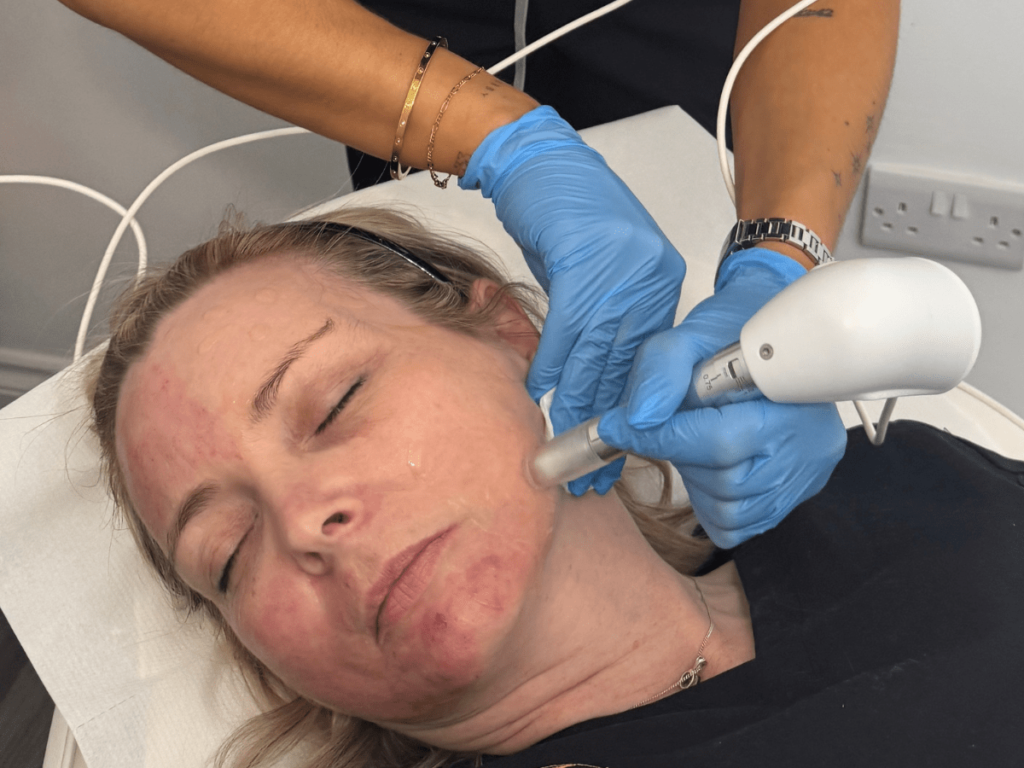
With the abundance of skin rejuvenation treatments available today, choosing the right one can feel overwhelming. From lasers to chemical peels, each option claims to offer something unique, but few are as versatile and effective as microneedling. So what sets it apart?
Microneedling isn’t just a treatment; it’s a solution that tackles a variety of skin concerns. Unlike many treatments that focus on just one issue at a time, microneedling works on multiple fronts, making it a go-to for those seeking comprehensive, natural-looking results.
In this article, we’ll explore what makes microneedling a standout choice in the world of skincare. From its ability to target everything from fine lines and scars to skin texture, let’s dive into why this treatment is worth considering in your skincare journey.

Microneedling vs. Other Treatments
Microneedling vs. Chemical Peels
Chemical peels focus primarily on the surface of the skin. They use a chemical solution to exfoliate the outermost layer, removing dead skin cells and revealing a smoother, brighter complexion underneath.
While effective for addressing surface-level concerns like hyperpigmentation, fine lines, and acne, superficial chemical peels don’t penetrate beyond the skin’s surface to promote deeper, long-term skin regeneration.
On the other hand, microneedling goes a step further by targeting the deeper layers of the skin. Using tiny needles to create micro-injuries, it stimulates the body’s natural healing process and encourages collagen production at a deeper level.
This makes it particularly effective for treating concerns that lie beneath the surface, such as acne scars, deep wrinkles, and overall skin texture. By triggering the body’s collagen and elastin production, microneedling offers long-term skin benefits that go beyond superficial improvements.
Microneedling vs. Laser Therapy
Microneedling is generally more affordable compared to laser therapy. While prices can vary depending on the provider and location, microneedling typically costs less per session.
On average, a microneedling session can range from $100 to $700, while laser therapy sessions can range from $500 to over $3,000, depending on the type of laser used.
Microneedling has minimal recovery time. While you may experience some redness and mild swelling for 24 to 48 hours after treatment, most people can return to their normal activities fairly quickly.
In contrast, laser therapy may require a longer recovery time, anywhere from several days to a week. In many cases, patient experience peeling, redness, and pain that lasts much longer than with microneedling.
One of the standout advantages of microneedling is its versatility across different skin types. It’s considered safe for most skin tones, including darker skin tones, and carries a lower risk of hyperpigmentation or scarring compared to certain laser treatments.
Laser therapy, while effective for skin rejuvenation, may not always be suitable for all skin tones. Some laser treatments, especially those using intense light, carry a higher risk of causing pigmentation issues in darker skin tones.
Microneedling vs. Dermaplaning
Microneedling is a more intensive treatment that targets the deeper layers of the skin. This makes it especially effective for treating concerns that go beyond surface issues, such as acne scars, deep wrinkles, and uneven skin texture.
The effects of microneedling are long-lasting, as the enhanced collagen production continues to improve the skin’s appearance for months after the treatment.
On the other hand, dermaplaning is a more superficial treatment. It involves using a surgical scalpel to gently exfoliate the top layer of dead skin cells and peach fuzz. While it leaves the skin feeling smooth and radiant, it doesn’t penetrate the skin deeply enough to promote the collagen production necessary to address scarring or wrinkles.
Microneedling vs. Botox/Fillers
Microneedling is primarily aimed at enhancing the overall health and texture of the skin. It works beneath the surface to promote natural skin regeneration, resulting in a more youthful, smoother appearance over time.
The benefits of microneedling are long-lasting, with a focus on improving the skin’s internal structure and health, rather than targeting superficial signs of aging like volume loss.
Botox and fillers focus more on addressing volume loss and expression lines. Botox works by temporarily paralysing muscles that cause expression lines, offering a smooth and relaxed appearance.
Dermal fillers are used to restore volume in areas where it’s lost over time, such as the cheeks, under the eyes, or along the jawline. Fillers plump up the skin and help to fill in deep wrinkles, providing an immediate and noticeable improvement in facial volume.
While Botox and fillers give fast, targeted results, their effects are temporary and need to be repeated regularly to maintain the desired look. Microneedling works gradually, with lasting improvements in the texture, firmness, and overall health of the skin.


Conclusion
In the world of advanced skincare solutions, microneedling stands out as a cornerstone for long-term skin health. Its ability to address a wide range of concerns makes it an incredibly versatile and customisable treatment.
By stimulating collagen production deep within the skin, it works to improve the skin’s structure and appearance over time, ensuring lasting results that go beyond just superficial fixes.
Microneedling offers a solution that works with your skin’s natural healing process. It can be tailored to target your specific skin concerns, making it suitable for most skin types and ages. It remains a go-to treatment for anyone seeking a holistic, effective approach to skin rejuvenation.
So, are you still curious how microneedling stacks up for your skin? Schedule your Skin Suite Starter today and find out why it’s the ultimate standout in skincare.

Bibliography
- Alina Goldenberg. (2024). Microneedling: The Benefits and Side Effects of This Skin Treatment. [online] Available at:
https://www.goodrx.com/health-topic/dermatology/what-is-microneedling.
- Alessandra Zonari. (2024). What is Microneedling & Are There Alternatives?. [online] Available at:
https://www.oneskin.co/blogs/reference-lab/what-does-microneedling-do.
- IG Beauty Laser and Skin Clinic. (2024). Microneedling vs other Skin Treatments. [online] Available at:
https://www.igbeauty.com/blog/microneedling-vs-other-skin-treatments.







